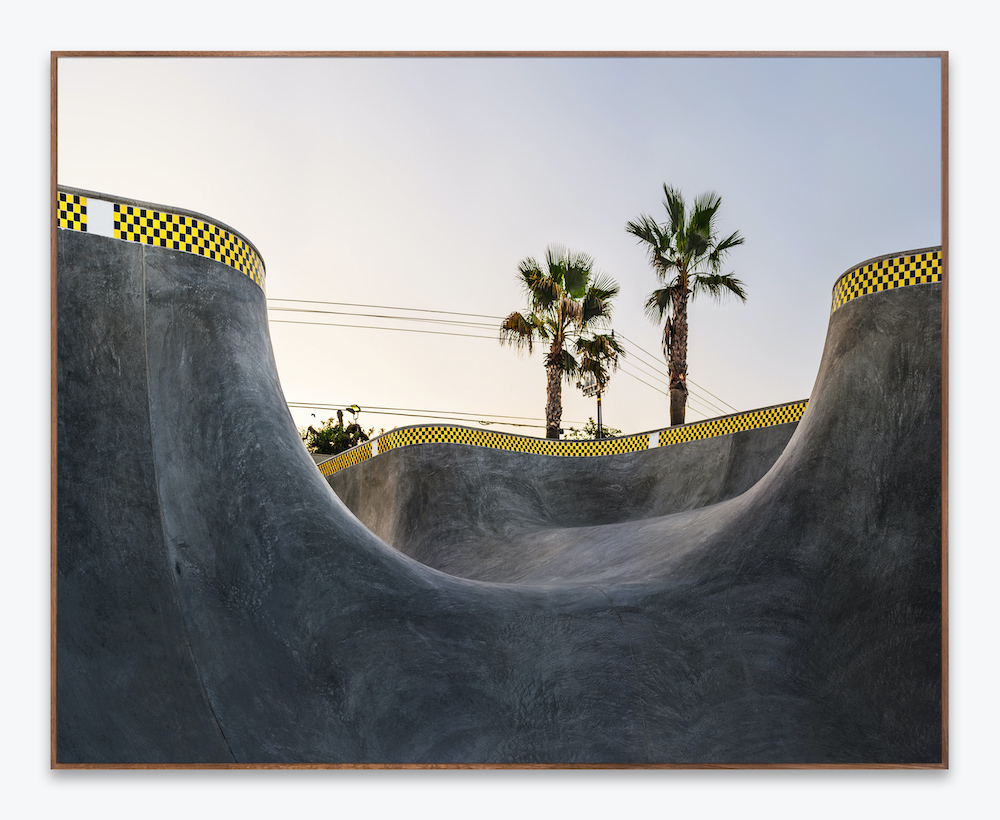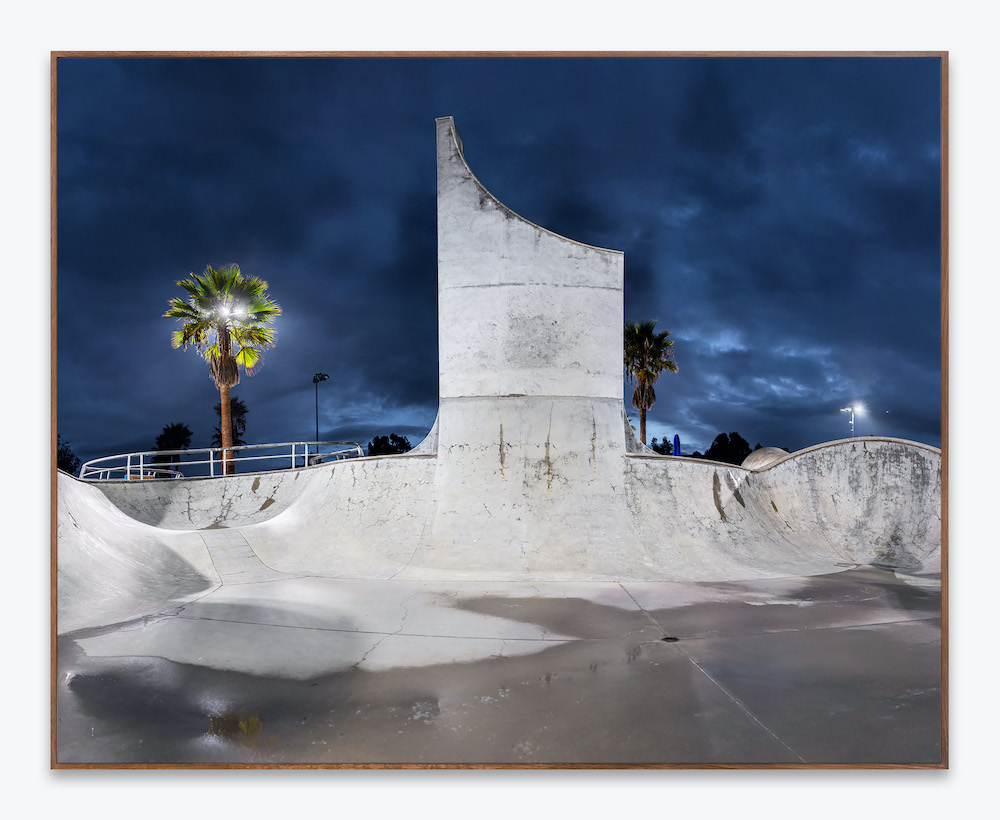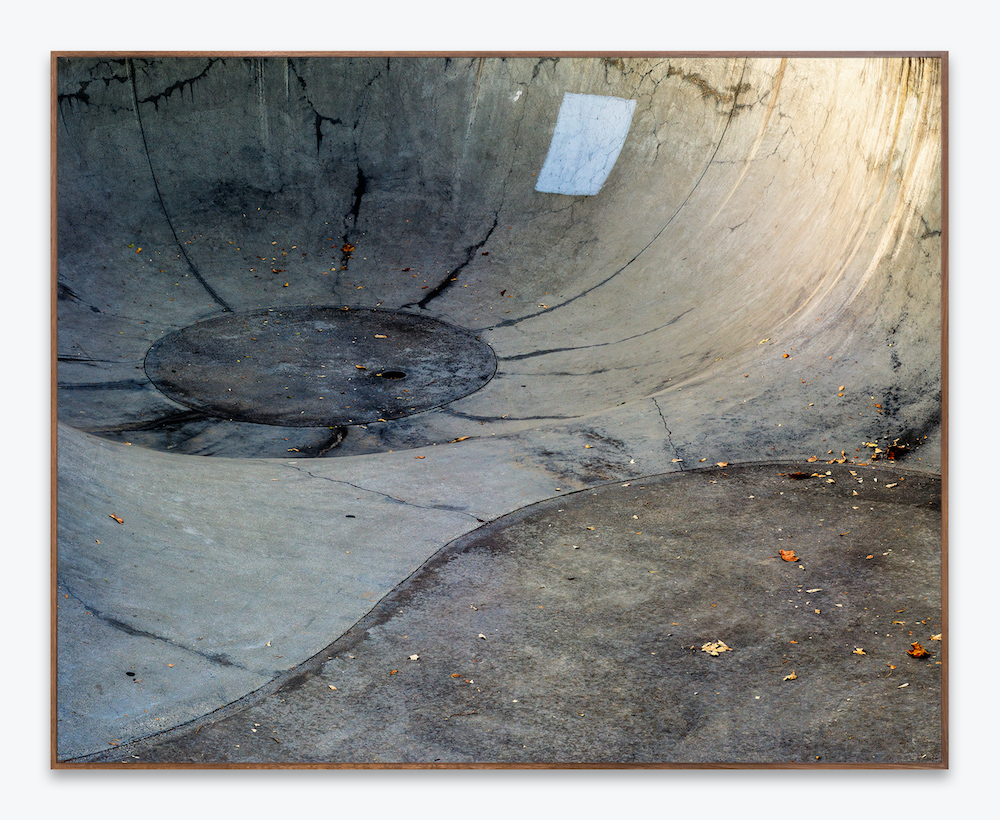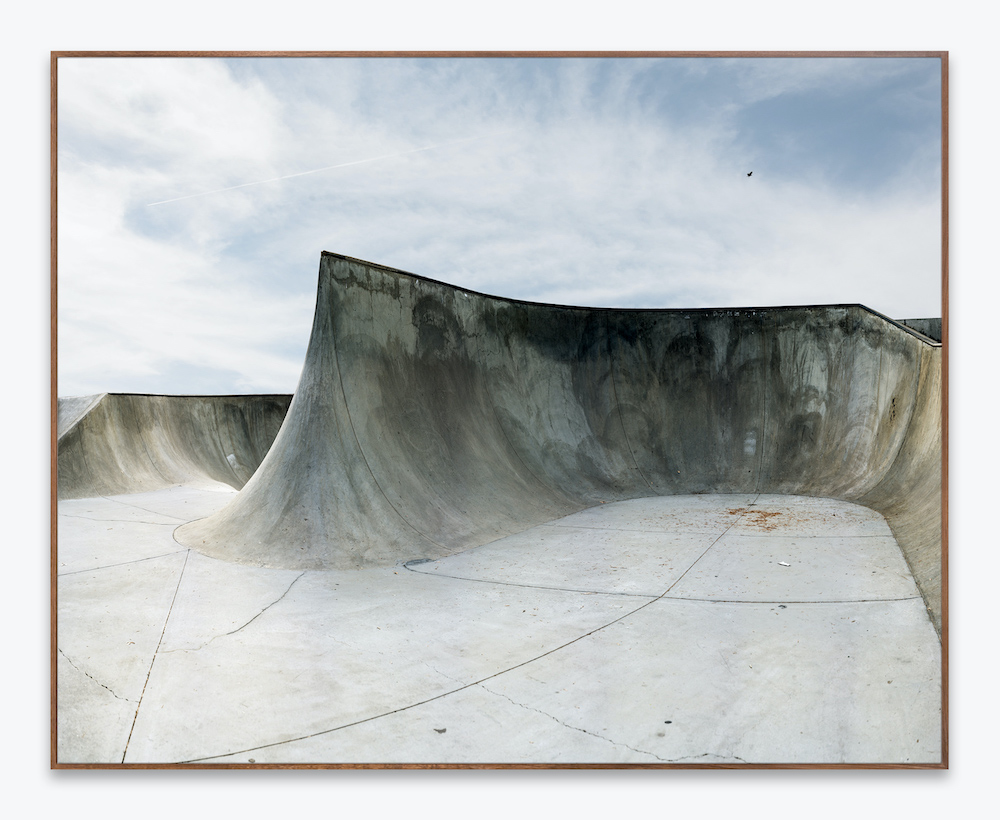This interview with Amir Zaki was conducted on September 16, 2019, in advance of his exhibition “Empty Vessel” at Orange Coast College’s Frank M. Doyle Arts Pavilion from Sept. 19–Dec. 5, 2019.
Christopher Michno: “Formal Matter,” the last body of work your exhibited at ACME (2017), referenced Modernist landscape photography in the West, and in California, especially Edward Weston. It also engaged with the discourse about photography’s truth claims — which has been an ongoing theme in your work from the beginning. Starting with the mid-century modern homes, which are very improbably perched on precipitous hillsides (“Spring Through Winter”), through to this new series on skate parks (“Empty Vessel”), you appear to address iconic images of California, but in a subversive way.
Do you see the work as a way to undermine or problematize notions of the California dream?
Amir Zaki: Maybe. The dream part is an interesting one. The photographs I make are essentially manifestations of my desires. It took me a while to figure that out, but basically that’s how I view what I’m doing digitally: I’m manifesting images of California, or wherever I am, which are about my desire — which means that if I happen upon this place that fits within this desire, I photograph it.
If I need to alter the image in post-production to make that better, I’ll do that. That’s how I view the idea of truth or the veracity of photography.
As far as the dreams, I don’t know what someone else’s notion of California is, so in that way, maybe I’m undermining someone else’s idea of California.
In regard to manifesting your desires, I’m interested in the gap between the reality and an idealized or “pure” experience. What motivates you to digitally alter your images?
So much of photography is about observation. I’m cultivating and fine-tuning that observational skill, which is often about finding interesting things that would be otherwise overlooked. And it’s not just the subject of the landscape but where my body is within the landscape.For example, with the Neutra homes, those photographs were about being underneath those structures. That’s not the point of view you’d normally see that photograph taken from. So these photographs emphasize the location of the subject, which is the viewer. The viewer becomes my set of eyes, and you now are in the position I was in.
Within these skate parks, a lot of what is both alienating, and I would hope, engaging about them is that the photographs are taken from positions that you’re in only when you’re inside of them. These are not from the perspective of the observer — the parents outside the fence looking in. That is a through-line in my work: where I am as the subject.
There are also never people in my photographs, and that allows you to become the subject. Any photograph with a person in it, immediately that person becomes the subject. But in my pictures, the viewer as the subject is a surrogate for me as the subject.

Amir Zaki, Concrete Vessel 130, 2019. Courtesy of the artist.
The scale of your photographs is immersive. There’s also a perceptual aspect that relates to how your digital alterations shape the viewer’s perception of the space, which seems related to how we experience and remember places. Our observation is bounded by time and position and our own perception and recollection. So when we return to a place, it’s not exactly the way we remember it.
Is that something you’re thinking about when you’re photographing, or is that just a by-product of the work?
It’s really important. This project actually started and hit a dead end four years ago when I was skating — again — in my middle age. I realized then how incredible skate parks are, architecturally and formally, but I couldn’t figure out how to make it work with all the people and fences. It dawned on me a couple of years later that I should show up early in the morning, which is when I want to photograph anyway.
I never know what I’m going to do in post-production, especially when I start a project. That comes through play. I go through lots of variations. For nine months, all this work was in black and white. At some point I decided to do it in color, and I became interested in the subtle variations of concrete.
You mentioned the body of work of the rocks on the beach (“Formal Matter”). I noticed that in the last 10 years, in post-production as I was zooming in and looking carefully at my photographs, there would be a random bird somewhere, which I definitely didn’t notice when I photographed it. One of those beach scenes has a hummingbird in it, and it’s so out of place. It just happened to be captured by the the gigapan system I’m using. I don’t know how much you know about it, but these are all stitched together from multiple images. Let’s just say this scene is made of 40 to 60 photographs. It zooms in. You’re using a telephoto lens, and you’re registering the top left and bottom right, and that’s all the machine needs. It photographs rows and columns of images. Each image might take five or even ten minutes; it depends on how meticulous I am and on a lot of other things.
The light changes and other things can happen. For instance, birds come in and out of flight. It could have been coincidence, but I started noticing early on in this project that sea gulls and crows gravitate to skate parks.
I thought of sea gulls and crows as the most banal of birds. For entertainment purposes, I started photographing them separately. Then I decided that every photograph of the sky would have a bird, so I’d either have one in the photograph naturally or put them in during post-production. I don’t distinguish between the two.
So that’s where you depart from the veracity of the image?
Absolutely. And some of the modernist ideals that I’m also really indebted to. Weston is a hero, but that would be sacrilege. But that seems to be the most truthful position to take at this moment and in relation to when I learned photography as it transitioned from analog to digital. It makes the most sense to me to use all these tools at hand. And I’ve always been suspicious of celebrating a photographer’s good luck. The idea that someone happened to be in the right place at the right time to capture something is put on the pedestal. But I can make a photograph that manufactures that and the resulting image is identical. The difference is an ethics that’s built into celebrating that moment of good fortune.

Amir Zaki, Concrete Vessel 71, 2019. Courtesy of the artist.
There’s a kind of Platonic purity and sublimity to the images you make, yet you’re introducing these distortions.
I’ve always thought skate parks are incredibly seductive — in their geometry and austerity. Your pictures of rocks isolated on those beaches and the iconic houses — these also reflect an austere formality. Where do you think that comes from?
Probably my love for photography is built on images that I love and find really arresting. I teach photography and show my students the canon of all these photographers. I still get really excited about all sorts of photographers — surprisingly some of them doing very different work than what I do. There are portrait photographers who I think are really incredible, and that’s something I could never do. And certainly there is a long history of the built landscape and the natural landscape.
Beauty is a tricky word, but I’m unapologetically interested in making beautiful things. I think that at the same time, there is usually an element of alienation or foreboding quality in the work, or at the very least, something that makes you ask, ‘What is this?’
The work you’re talking about, with the Neutra homes, I had architects say, wow, that’s crazy that it stands like that. I had done all this digital stuff, and I’d say, well, no, it didn’t, and I did this to it. And then with the lifeguard towers, there were people who didn’t know they were lifeguard towers. So with almost every body of work, there’s an element of surprise for me. What I’m doing is making these things less familiar. Where I stand, and how I’m photographing it, isolates and decontextualizes it.
I have talked to a lot of people who feel the way I do about the work, but I showed this work to a curator early on, and they had a drastically different response to the concrete. It reminded her of concentration camps. That was important for me because it was a negative reaction to the look of these forms. So I’m totally optimistic about these. It goes back to my desire. I’m trying to make images that I can stand behind and that I think are beautiful, engaging and slightly strange, but certainly not negative.
This gets at what I brought up earlier about deconstructing the California dream. You’re talking about decontextualizing these settings and these objects, making them strange. Part of that has to do with defying easy recognition. Another part of it is that the alienation you’re talking about has to do with taking these very iconic subjects that have defined particular cultural moments. For example, the Neutra homes, those represent what is regarded now as elegant design, but they grew out of a particular European architectural movement that aspired to bring low-cost socialist housing to Southern California, and it failed.
Skating as we know it emerged from the experience of the so-called Z-Boys, who developed a guerilla-style of skating. They overturned the staid skate competitions of the 1970s and skated empty swimming pools. Skaters create their own community in skate parks, and some of them live marginalized lives. I’m reading into what you’re creating as taking something very iconic and pointing to an alienation that sits underneath that idyllic notion. But there is an extensive social history that informs these and can be inferred.
I think that’s a good way of putting it. When I think about the work or write about the work, I often return to ideas about function and dysfunction. The Neutra homes, yes, and especially what I did to them: removing any visible support that they could have and photographing them from their underbelly was really about highlighting the dysfunction, but in a monumental way. I still want them to be heroic, but the way I’m looking at them highlights a dysfunction.
The skate park photographs are similar. Without skaters in them, I was photographing things that are a little more subtle. For example, photographing after it rains so there are puddles, or with leaf piles in the images—those are important aspects. That highlights dysfunction. Those conditions are a bad if you want to skate. For me, of course, it becomes something important. The signage that would be the park rules—I’ve done this for years—when there’s a sign in the photograph I turn it into monochrome. I don’t know if what you are getting at is that I’m looking at them in an ahistorical way, but I’m not foregrounding the social part of the work. I’m also not ignoring it. I’m thinking about it, clearly. You can’t erase it, for one. I didn’t make the pile of leaves like that; it’s just a byproduct of that space. So I hope that people think about the social, but it’s approached from the perspective that I’m making visual art. I’m interested in the process of working from the bodily to language. If I wanted to be language-based or talk about the social context based in language, I’d write. But I’m not a writer.
That’s the way I would approach that subject if that were the most important thing, to talk about the social history of skate parks, or Neutra, or housing. I’d probably approach it in a different medium altogether. I feel that the strength of a visual medium is how it affects parts of your being that are pre-language.
It’s also an open signifier.
And this work particularly — this was definitely an accident — but the pop-culture quality of this particular subject matter is something I haven’t explored before. The Neutra homes and the rocks are more esoteric. This series came from the same reasoning, the same desire to look at some part of the landscape that I feel hasn’t been explored in the way that I’m interested in exploring it. But skating is so—it’s going to headline the 2020 Olympics. It clearly has become a huge pop-culture reference.

Amir Zaki, Concrete Vessel 31, 2019. Courtesy of the artist.
Back to iconography, I read that these are all very recognizable parks?
There are hardly any that aren’t recognizable. Anybody who’s a local will recognize them. I showed these photographs in Seattle, and there happened to be a kid there who was really into traditional skateboard photography. He knew all of these parks. He looked at one and said, ‘I’ve been to that park. Did you do something to that?’ He could tell I had distorted some of the landscape.
Are the parks all in California?
Yes. I have fantasies about expanding this project to other places. There have been a couple that I was just too scared to photograph. People get really local about them. There’s one in San Diego that’s in a really sketchy industrial place, with a chain link fence. Others I was just able to get in.
I didn’t photograph Venice, but I would like to. I think that will be very difficult. I could probably swing it in February at 6 am, maybe. I usually have about 2 hours, where a few people show up, and I’ll ask for a little time before they start skating. They’re usually really cool about it.
To be continued… Check in next week for Part 2 of this conversation.


